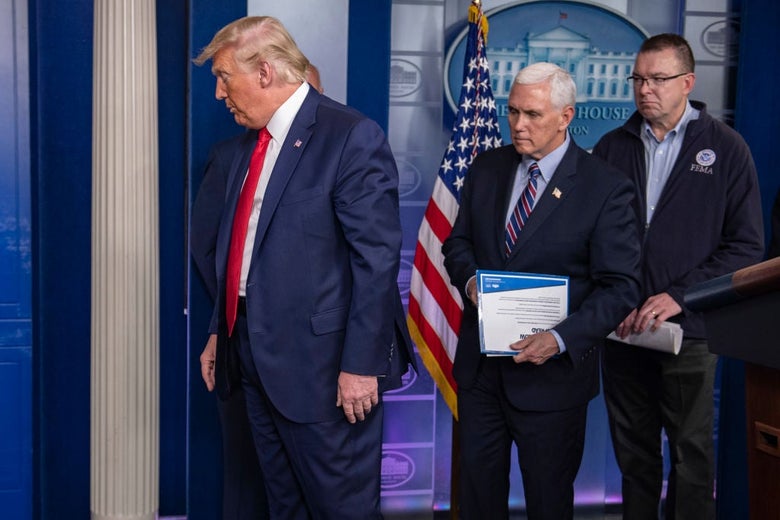
Donald Trump, Mike Pence and FEMA Administrator Peter Gaynor at the White House on Sunday.
Eric Baradat/AFP via Getty Images
The hopeful period during which Donald Trump was taking the advice of public-health professionals appears to be over. Sunday night, he tweeted this:
Monday morning, he (or his approved social media henchmen) retweeted several sycophantic MAGA accounts which were repeating talking points about getting the country “back to work” at the end of a 15-day lockdown period in order to preserve the “economy President Trump has built up.”
If you’re not clear on what this 15-day national lockdown even is, given that many states have yet to prohibit large gatherings or close nonessential businesses, Bloomberg reports that it was a “plan from the Centers for Disease Control and Prevention to stem the rise of cases by encouraging most people to stay at home” and that it began last Monday. By Thursday, though—day three, of the scheduled fifteen, during which the president, unlike many people who are engaged in protective social distancing, is working in his normal environment without having his income interrupted or being expected to care for a child or elderly person—Trump began to panic and “started talking about how to get people back to work.” Bloomberg notes that this idea, of getting employees who are still healthy back on the job, has also been aired in public comments by such figures as former Goldman Sachs CEO Lloyd Blankfein and former Trump adviser/Goldman Sachs executive Gary Cohn.
As respected as Lloyd Blankfein is in public-health circles, the problem with his analysis would seem to be there continue to be more reported U.S. coronavirus cases and deaths each day than there were the day before. (Italy, which began an actual nationwide lockdown thirteen days ago, has still not flattened its curve either.) The trend would be exacerbated by sending workers (who can spread the virus even if they are asymptomatic) back into workplaces where they routinely stand or sit within six feet of colleagues for long periods. Many of them, moreover, would be using public transportation (which at-risk individuals would also be using to e.g. go to the grocery store or the doctor) to get to work in the first place.
The approach could possibly work if testing became widely available enough to immediately identify and quarantine carriers, and if filtered masks could be distributed to those who were able to leave the home, as they have been in South Korea. But the CDC (which is part of the Trump administration) prepared only a limited number of faulty tests in January and February, creating a shortage that other producers have still not been able to make up. Medical supplies like masks are also running out, and Trump still has not used the Defense Production Act to order companies to make them. He has not done enough preparation, in other words, to abandon the emergency policy that is currently struggling to contain the damage he created by not preparing.
Everyone stay inside! Don’t listen to the president.
Readers like you make our work possible. Help us continue to provide the reporting, commentary and criticism you won’t find anywhere else.
Join Slate Plusfrom Slate Magazine https://ift.tt/2WD6jOQ
via IFTTT
沒有留言:
張貼留言